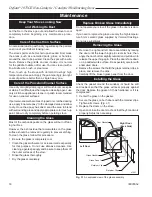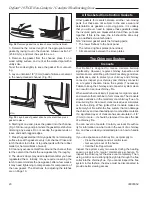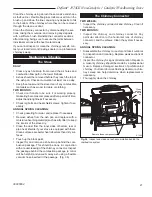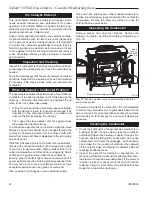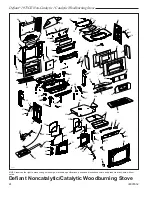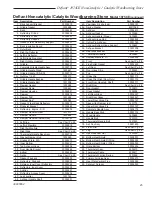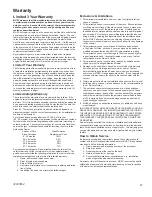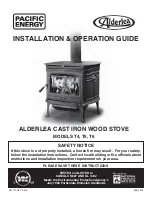
Defiant
®
1975CE Non-Catalytic / Catalytic Woodburning Stove
30005554
T
he catalytic element
This wood heater contains a catalytic combustor, which
needs periodic inspection and replacement for proper
operation. In the United States it is against the law to op-
erate this wood heater in a manner inconsistent with the
operating instructions in this manual.
Under normal operating conditions, the catalytic combus-
tor should remain active for two to six years (depending
on the amount of wood burned). However, it is important
to monitor the combustor periodically to ensure that it is
functioning properly, as well as to determine when it needs
to be replaced. A non-functioning combustor will result in
a loss of heating efficiency, and an increase in creosote
and emissions.
inspection and cleaning
Inspect the combustor for fly ash accumulation and physi-
cal damage three times per year. Clean the combustor as
needed.
The refractory package that houses the catalytic combustor
should be inspected for a buildup of fly ash and cleaned
if necessary. This may be done when you examine the
combustor.
when to Suspect a combustor problem
The best way to evaluate the performance of your Defiant’s
combustor is to observe the amount of smoke leaving the
chimney — both when the combustor has “lighted-off” and
when it has not. Follow these steps:
•
With a fire going and the combustor properly activated,
with the damper closed to route smoke through it as
described in the Operation Section, go outside and
observe the smoke leaving the chimney.
•
Then, open the stove damper and once again check
the smoke leaving the chimney.
You should see significantly more smoke when the stove
damper is open and exhaust does not pass through the
combustor. However, be careful not to confuse smoke with
steam from wet wood. Steam dissipates in the air quickly;
smoke does not.
If this test indicates a problem, consider other possible fac-
tors as well, such as the weather or a change in the quality
of your fuel. In warm weather, draft is weaker than it is in
colder winter weather, and fires can burn sluggishly. Small,
hot fires are a good solution under these conditions.
Burning “green” (insufficiently seasoned) wood will result in
poorer performance than burning properly seasoned fuel.
You may have to run your stove hotter (more air) to achieve
acceptable performance using green or wet wood.
Also, consider any changes in your operating routine.
Once you have ruled out any other possible causes for a
decline in performance, inspect and clean the combustor
if necessary. Be sure to protect any surface you use for
setting the stove parts aside.
inspecting the combustor
Remove access door and inner fireback. Remove the
catalytic combustor by lifting and sliding it towards you.
(Fig. 37)
To assure a long life for the combustor, it is recommended
to service the combustor on a regular basis based on the
amount of use. This procedure takes about five (5) minutes
and requires no tools except for a vacuum if cleaning is
necessary.
cleaning the combustor
1. Check the combustor’s honeycomb-like element for a
buildup of fly ash. If any is evident, take the combustor
outside and clean it by blowing air gently through it. Do
not push anything through the honeycomb; do not use
compressed air to clear the passages. Such abrasion
can scrape the thin coating of platinum (the catalyst)
off the ceramic base, shortening the catalyst’s life and
reducing its effectiveness.
. Inspect the element for damage or degradation. Al-
though small hairline cracks will not affect performance,
the element should be essentially intact. If the element
is broken in pieces or has sections missing, it should be
replaced. Call your local Vermont Castings Authorized
Dealer for a replacement element.
ST1162
ash clean out
Clean
out any
ash build
up
Remove these components
ST116
Fig. 37
Inspect and clean out ash accumulation behind the
combustion system.











